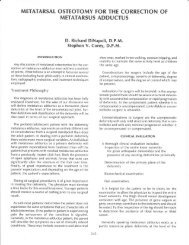surgical techniques of hallux amputation - The Podiatry Institute
surgical techniques of hallux amputation - The Podiatry Institute
surgical techniques of hallux amputation - The Podiatry Institute
Create successful ePaper yourself
Turn your PDF publications into a flip-book with our unique Google optimized e-Paper software.
CHAPTER 37 205<br />
POSTOPERAITVE MANAGEMENT<br />
Most postoperative regimes following halh:x<br />
<strong>amputation</strong> initially require strict non-weight bearing<br />
<strong>of</strong> the involved extremily. It is important for the<br />
podiatric surgeon to not neglect the contralateral<br />
1imb, which is at increased risk. This requires<br />
frequent monitoring and protective measures. <strong>The</strong><br />
use <strong>of</strong> the Cam walker is an excellent regime to<br />
progress from a non-weight bearing to a pafiial<br />
weight bearing status. <strong>The</strong> Cam walker can be used<br />
effectively until it is appropriate to advance to the<br />
use <strong>of</strong> a shoe. An extra depth shoe with a prescribed<br />
plastizote medial forefoot filler and inlay, combined<br />
with a rigid shank is recommended for ambulation<br />
following successful healing. <strong>The</strong> use <strong>of</strong> a neutral<br />
position <strong>of</strong>ihotic device with intrinsic forefoot<br />
posting helps to control the potential postoperative<br />
forefoot varus position following <strong>hallux</strong> <strong>amputation</strong><br />
surgery.<br />
Historically, diabetic patients presenting with a<br />
foot r:lceration would have had an <strong>amputation</strong> at a<br />
proximal level because <strong>of</strong> the assumed inabiliry to<br />
heal at the level <strong>of</strong> distal <strong>amputation</strong>s. \7hen an<br />
infection has involved the plantar spaces <strong>of</strong> the foot,<br />
it has been believed that the only hope <strong>of</strong> saving the<br />
patient's limb was to perform a guillotine<br />
<strong>amputation</strong> <strong>of</strong> the affected limb. \(hen a<br />
neurotrophic diabetic patient presents with foot<br />
ulcerations, it is not always necessary to perform a<br />
proximal <strong>amputation</strong>. Partial forefoot <strong>amputation</strong>s<br />
such as a <strong>hallux</strong> <strong>amputation</strong> a1low the minimum<br />
possible <strong>amputation</strong> at the lowest level with a major<br />
advantage <strong>of</strong> the ability to bear weight.<br />
BIBLIOGRAPHY<br />
Bilk D. Selby JV, et al: Lower extremity <strong>amputation</strong>s in people u'ith<br />
cliahetes: epidemiology and prevention. Diabetu Care 1,990:73:573.<br />
Chang B, Bock D, Jacobs R, Darling R, Leather R. Shah D. Increased<br />
limb sah'age by the use <strong>of</strong> unconventional fbot <strong>amputation</strong>s. Jr<br />
V as c S urg 7994;79 :347 -9.<br />
Downs DM, Jacobs RL. Treatment <strong>of</strong> resistant ulcers on the plantar<br />
surfhce <strong>of</strong> the gleat toe in diabettcs. J Bone Jaint Swg Am<br />
7L)82:64:930-3.<br />
Duggar. GE, et a1, Time-Line for the diabetic frrot. In: McGlamry ED.<br />
editor. <strong>Podiatry</strong> Instltute Update 1987. Tucker (GA): Podiatrl,=<br />
<strong>Institute</strong> Publishing; 1987.<br />
Fronek A, Coel M, Bernstein EF. <strong>The</strong> imp<strong>of</strong>iance <strong>of</strong> combined muitisegmental<br />
pressllre and Doppler flon' r'elociqv stuclies in the<br />
diagnosis <strong>of</strong> peripheral arterial occlusive disease. Sarxerl'<br />
1978;8'1:840-7.<br />
Gavin, LA. Perioperative management <strong>of</strong> the diabetic patient:<br />
enclocrinology and metabolism Clin N Am 7L)92;21:157-75.<br />
Goldstein B, Citron D, Neshit C. Diabetic foot infections. Diabetes Care<br />
7996;79:638-41.<br />
Griffiths, GD, \i7ieman, TJ. N,{eticulous attention to foot crre impror-es<br />
the prognosis in diabetic ulceration <strong>of</strong> the foot. Surgerl Gyn Obst<br />
7992:174:19 51.<br />
Lance B, Kirschenbaum S. Distal ischemia s'ith digital gansirene sec<br />
ondary to buerger's clisease../ Faot Sarg 1991;30,531 17.<br />
Levin M. Foot lesions in patients w-ith cliabetes mellitus. Cbron Comp Diab<br />
7996;25'147-55.<br />
Levin ME, O'Neil L\Xr. <strong>The</strong> Diabetic Foot. St. Louis: CV Nlosb-v; 1!88. p.<br />
77.<br />
Pinzur NIS, Gold J, SchnartT- D, et al. Energv demands for u'alking in<br />
d\rsvascular xmplltees as related to the level ot.L]nlputetion. OrtbLl)<br />
199275:1033-1 .<br />
Pinzur MS, Sage R, Abral'ram NI, et al. Limb salvage in inf'ectecl lori-er<br />
extremity gangrene. Foot Ankle 1988:8:212-5<br />
Sizer JS,<br />
\Mreelock FC. Digital <strong>amputation</strong>s in diabetic patients. SzzrgerT<br />
7972:i2:L)80-9.<br />
litti M. Robinson D, Hauer-Jensen M, Thompson B. Ranval T, Barone<br />
G, et a1. Vound healing in fbrefoot <strong>amputation</strong>s: the predrctive<br />
r:lrre <strong>of</strong> 1,,( fre

















